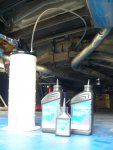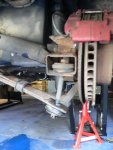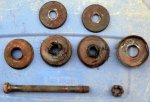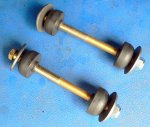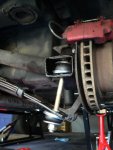antijam
CCCUK Member
Well, I finally got round to one of the jobs that my recently acquired Quickjack was intended for - sorting out the useless C3 handbrake! Having gone through the motions of the standard adjustments - brake shoes and cable adjustment - to no effect whatsoever, I armed myself with a comprehensive set of replacement goodies (courtesy of CK)......

.....hoisted the car off the ground and lifted off the calipers to see the worst.
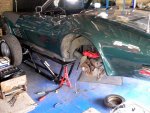
It was obvious that a previous owner had been there before me and by the look of it had tried the easy replacements and given up on the more difficult ones. The front and rear cables looked newish, although the rear was not original pattern (it proudly bore the label 'China') and lacked the proper armouring between the frame and trailing arm. The rotors were in excellent condition and obviously recently replaced, which meant at least I didn't have to drill out the rivets to remove them. Once removed they revealed a very un-pretty sight. The shoes themselves were in quite good condition - not surprising since they had been doing nothing - everything else was a tapestry of rust...

The workshop method of parking brake overhaul is very straightforward - once you remove the rear spindle assembly. This wasn't a job I wanted to get into so I elected to follow the simpler but less easy method. This is well documented in literature and videos on the web so I won't go into detail, but my main worry was that the brake back plates were in pretty sorry condition and these can't be replaced without spindle removal. Previous owner had done some serious bodging to try to remove the brake actuating lever and strut in one piece - despite them being obviously designed to come apart - and the resultant widening of the slot in the plate meant potential problems when re-assembled.
Anyway, I straightened them out as far as possible, stripped out everything and started rebuild with new parts. The original shoe retainers were toast so new ones had to be split to fit them behind the shoe anchor bolts and then tack welded back together again. The supposedly trickiest bit of assembly is fitting the shoe retaining springs and collars over the retaining pins. I found that with the pins held captive with a loop of fishing line, fitting the springs and collars wasn't too bad.
With everything back in place and new cables fitted....
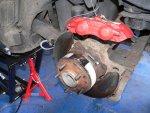
.....( the armouring on the rear one makes fitting this a trial of strength!) and basic adjustments made, it was back on the ground and off for a drive to 'burnish' the new shoes. Okay, a few readjustments need to be made after burnishing, but at last I have joined what I suspect is a fairly exclusive club - C3 owners with a functional handbrake!

.....hoisted the car off the ground and lifted off the calipers to see the worst.

It was obvious that a previous owner had been there before me and by the look of it had tried the easy replacements and given up on the more difficult ones. The front and rear cables looked newish, although the rear was not original pattern (it proudly bore the label 'China') and lacked the proper armouring between the frame and trailing arm. The rotors were in excellent condition and obviously recently replaced, which meant at least I didn't have to drill out the rivets to remove them. Once removed they revealed a very un-pretty sight. The shoes themselves were in quite good condition - not surprising since they had been doing nothing - everything else was a tapestry of rust...

The workshop method of parking brake overhaul is very straightforward - once you remove the rear spindle assembly. This wasn't a job I wanted to get into so I elected to follow the simpler but less easy method. This is well documented in literature and videos on the web so I won't go into detail, but my main worry was that the brake back plates were in pretty sorry condition and these can't be replaced without spindle removal. Previous owner had done some serious bodging to try to remove the brake actuating lever and strut in one piece - despite them being obviously designed to come apart - and the resultant widening of the slot in the plate meant potential problems when re-assembled.
Anyway, I straightened them out as far as possible, stripped out everything and started rebuild with new parts. The original shoe retainers were toast so new ones had to be split to fit them behind the shoe anchor bolts and then tack welded back together again. The supposedly trickiest bit of assembly is fitting the shoe retaining springs and collars over the retaining pins. I found that with the pins held captive with a loop of fishing line, fitting the springs and collars wasn't too bad.
With everything back in place and new cables fitted....

.....( the armouring on the rear one makes fitting this a trial of strength!) and basic adjustments made, it was back on the ground and off for a drive to 'burnish' the new shoes. Okay, a few readjustments need to be made after burnishing, but at last I have joined what I suspect is a fairly exclusive club - C3 owners with a functional handbrake!

